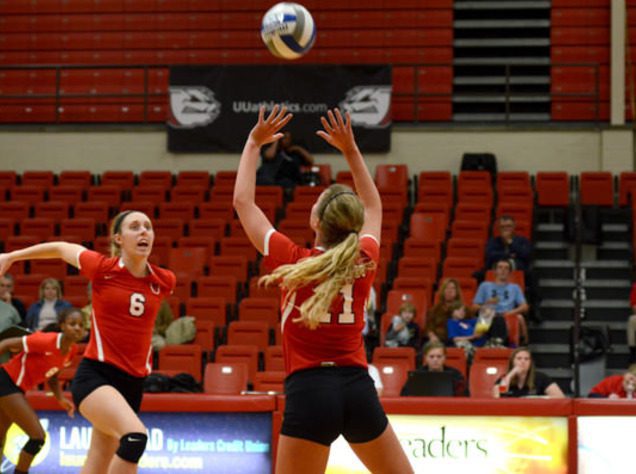Believe it or not, the setter is one of the most important athletes in volleyball and most teams will be dead in the water without one. Now, how is this possible? Although the untrained eye may see the setter as an unglamorous position because they’re not always physically scoring points, but they’re often the reason why a team succeeds altogether. Ultimately, how are your hitters supposed to score without a good set-up pass? If your hitters are constantly adjusting to poor sets, then they’ll have less time to focus on finding empty space on the other side of the net.
The position of setter has most typically been compared to a point guard in basketball — while these athletes are perfectly capable of scoring, their main responsibility is to run the offense, set up their teammates, and help put them in positions to succeed. Additionally, it wouldn’t be hard to find similarities to a quarterback as well; they call the shots, instruct teammates, and are one of the team’s overall leaders. These players are some of the sport’s most consistent athletes because they understand where the ball needs to be at all times. Setters help calm the chaotic nature of the sport and is the all-important stepping stone towards potential success — if that sounds like your ideal role, then you’re in the right place! CoachUp has put together a guide to become the best setter you can be, so take this with you the next time you hit the court!

The Responsibilities
Above all else, the setter is the athlete that works to keep order on the court and does everything from calling the play to making sure everybody is lined up correctly. One of the only limitations on a setter is that they must stay behind the player in front of them, so, in most cases, their hitter will press up right against the net so the setter has room adequately pass. Contrary to popular belief, it’s the setter that dictates what the team will do on their offensive possessions and then helps the team move into position for execution. Just as the Libero must not attack and is generally contained to digging and diving, the setter has an innate focus on ball-handling and creating offense.
The Mentality
The mentality of the setter must go back to the aforementioned point guard comparison as he or she must be incredibly in-tune with their teammates. Where does your hitter like the set? Where does another? Do they like it high? Do they like it further from the net? If you’re running a certain play, where must you set it? Undeniably, the setter must be acutely aware of their ever-changing responsibilities with each opportunity.
A setter that understands the nuances of not only the game, but their teammates as well is a valuable asset. Although it takes some really disciplined effort and practice, there’s no reason why setters can’t learn the preferences of their attacking teammates. Additionally, this athlete needs to be full of the sport’s most important intangibles and an undeniable knowledge of the rules, situations, and ideal game planning. Preparation before the serve is key as well, as this allows them to instruct their teammates, visualize the execution, and make efficient decisions on-the-fly. Setters must be natural-born leaders and unafraid to communicate and change their teammate’s strategy on the court.
The Execution
CoachUp’s article about setting has some great tips about creating good habits, so we suggest heading over there to check that out. Ideally, a setter doesn’t just wing it every time a ball is headed their way, instead, it’s almost the exact opposite. Since the elite setters are mentally prepared before each serve, their most important factor in execution is consistency. Much like getting ready for an at-bat or sinking your free throws, setters should look to establish a routine. How do you prepare for a set? Where are you most comfortable hitting it? Certainly, there will tons of variables — from high hits or low digs — but having a set go-to method for your feet, arms, shoulders, and head can go along way towards dispelling any quick-reaction discomfort.
Remember, the more prepared you are before the big game, the better. Put in your time before and after practice, during your free time, and with a one-on-one coach in order to have yourself ready for whatever the game throws at you. Then, if you’ve got to deal with a low hit, you’ll be able to deal with it accordingly and immediately be able to focus on putting your teammates in the best situation to succeed.
(Related: Read about good habits for setting here.)
Huddle Up
At the end of the day, the setter position is far more intricate than most outsiders are willing to concede. It takes an incredible amount of pre-serve preparation, like moving and communicating with your teammates, and just as much athletic consistency as the rest of the team. If you ever see a silent setter, then they’re not living up to their potential as a leader, play-caller, and athlete. The very best setters are confident, collected, and consistent, ready to put their teammates in their preferred situations and doing it without difficulty again and again.
If you play setter and find these thoughts tough to implement or would like to evolve and add the ability to be a dependable setter to your game, then consider booking one of CoachUp’s private trainers to get you headed in the right direction. Again, the setter position is as much mental as it is physical and being ready pre-serve is as important as consistent play is. Don’t just play the game, compete and dominate! What are you waiting for?
Be prepared for the biggest moments by mastering the small ones off the court.
How useful was this post?
Click on a star to rate it!
Average rating 4.7 / 5. Vote count: 3
No votes so far! Be the first to rate this post.



